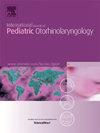Audiological assessment using click auditory brainstem response and chirp auditory steady-state response in pediatric patients with congenital microtia under 36 months: A single-center experience
IF 1.2
4区 医学
Q3 OTORHINOLARYNGOLOGY
International journal of pediatric otorhinolaryngology
Pub Date : 2025-03-24
DOI:10.1016/j.ijporl.2025.112320
引用次数: 0
Abstract
Objective
To investigate the audiological characteristics of congenital microtia (CM), and explores the effectiveness of click auditory brainstem responses (c-ABR) and chirp auditory steady-state responses (chirp-ASSR) in assessing hearing loss in affected children.
Methods
Audiological assessments were performed using c-ABR and chirp-ASSR in infants and toddlers under 36 months with CM who were unable to cooperate for behavioral testing. We used c-ABR to assess the nature of hearing loss. Spearman coefficients were used to evaluate correlations, and differences were assessed by subtracting c-ABR air conduction (AC) thresholds from chirp-ASSR AC thresholds. Additionally, differences were analyzed based on the external auditory canal status, auricle status, unilateral or bilateral CM.
Results
The findings indicate that most CM patients experience conductive hearing loss (CHL, 90.36 %) and mixed hearing loss (MHL, 8.21 %), with a smaller number exhibiting normal (0.71 %) or sensorineural hearing loss (SNHL, 0.71 %). Across the entire sample, ABR thresholds showed the strongest correlation with ASSR thresholds at an average of 2–4 kHz (r = 0.723). Chirp-ASSR was found to be a complementary test to c-ABR for screening hearing loss in CM patients, particularly when behavioral testing is not feasible. Significant differences were found in patients with external auditory canal atresia and stenosis, as well as in those with different auricle statuses (Grade I + II, and Grade III).
Conclusion
The study supports the use of c-ABR and chirp-ASSR as valuable tools in the audiological assessment of congenital microtia, aiding in early diagnosis and appropriate intervention for hearing loss in pediatric patients.
求助全文
约1分钟内获得全文
求助全文
来源期刊
CiteScore
3.20
自引率
6.70%
发文量
276
审稿时长
62 days
期刊介绍:
The purpose of the International Journal of Pediatric Otorhinolaryngology is to concentrate and disseminate information concerning prevention, cure and care of otorhinolaryngological disorders in infants and children due to developmental, degenerative, infectious, neoplastic, traumatic, social, psychiatric and economic causes. The Journal provides a medium for clinical and basic contributions in all of the areas of pediatric otorhinolaryngology. This includes medical and surgical otology, bronchoesophagology, laryngology, rhinology, diseases of the head and neck, and disorders of communication, including voice, speech and language disorders.

 求助内容:
求助内容: 应助结果提醒方式:
应助结果提醒方式:


